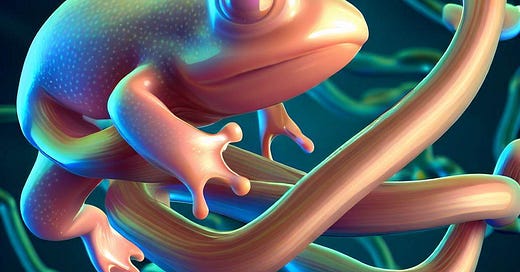Metamorphosis, that extraordinary biological process by which a creature takes on a completely different form during its development, is made possible by complex mechanisms at the molecular level. One of the most fascinating examples of metamorphosis in the animal kingdom is that of the tadpole that turns into the adult frog. To make this magical transformation possible is quantum physics, that bizarre discipline that describes the behaviour of matter at the subatomic level. The metamorphosis from tadpole to frog is an extraordinary symphony of nature that demonstrates the power of quantum physics to shape the biological world.
Chemical bonds are basically knots. Quantum tunnelling unties them, quickly. It transforms strong knots into weak knots. The tadpole’s body scaffold is made up of an intricate network of collagen molecules tightly knotted together. For this structure to disintegrate and reassemble in the shape of an adult frog, quantum principles must come into play. In the quantum world, protons in the nucleus of hydrogen atoms exhibit wave-like behaviour, allowing them to tunnel through energy barriers rather than having to overcome them as would happen to classical particles. Proton quantum tunnelling occurs at incredible speed. In the tadpole’s collagen bonds, this allows protons to escape through molecular orbitals, quickly dissolving the protein knots that confer structural rigidity. It is a delicate quantum prelude that relaxes molecular tensions. Then, quantum electrons dance in a solo of probability and potentiality, their waves guide the reassembly of collagen according to the shape of the adult frog. A symphony of quantum possibilities orchestrates metamorphosis.
The key enzyme that degrades collagen scaffolding during tadpole metamorphosis is collagenase. Collagenase belongs to a class of proteolytic enzymes known as matrix metalloproteinases (MMPs). These enzymes contain metal ions in their active site, typically zinc or calcium, which give them the ability to cleave peptide bonds in collagen. In particular, collagenase acts on bonds between glycine and isoleucine amino acids in collagen’s triple helix. This causes fragmentation of collagen fibres already partially relaxed by proton quantum tunnelling.
The activation of collagenase in tadpole cells is finely regulated by biochemical signals that induce gene expression during specific stages of development. The enzyme is secreted into the extracellular space where it can access and erode the disintegrating scaffold. Thanks to its ability to “pick” selectively at the robust mesh of collagen, collagenase is essential for allowing the rapid breakdown of tadpole body architecture during metamorphosis. Together with proton tunnelling, this enzyme makes possible the dramatic reconstruction of a tadpole body into a frog shape. Every particle performs its part in this performance, following the quantum laws that govern the atomic and molecular world. Nature cleverly exploits the intrinsic quantumness of matter to model life. Thus, tadpole transformation vividly demonstrates how the quantum dance of protons and electrons manifests macroscopically in the passage from one biological form to another. Metamorphosis is possible only thanks to the quantum nature of reality.
It is fascinating to think that the magic of metamorphosis lies in the microscopic world of atoms and elementary particles. When we admire ecstatically the wonderful transformation of a tadpole into a frog, we are actually observing the elegant quantum choreography of matter. Every living creature is an incarnation of this quantum dance. In us, protons and electrons incessantly perform their harmony to shape our very existence. We are ourselves symphonies of quantum possibilities. Perhaps even our mind could benefit from a sort of “quantum collagenase” that allows its continuous regeneration through the processes of learning, unlearning and relearning.
We should learn to be open to breaking down old ideas and preconceptions when they are no longer functional, just like the tadpole disassembles its larval structure. So we can rebuild a new “mental scaffold” more suited to the evolving reality as the tadpole recreates itself in the shape of the adult frog. Probably the awareness of the quantum nature of reality can help us in this, reminding us that everything is constantly changing. We can thus live with greater lightness and be creative agents of change, just like the dancing protons that make possible the metamorphosis of the tadpole.
The metamorphosis from tadpole to frog is an example of how nature manifests its diversity and complexity, but also of how ultimate reality is one and indivisible. The tadpole and the frog are two different forms of the same entity, which is nothing but the quantum field, the supreme principle that generates and sustains everything that exists. The quantum field never changes, but expresses itself in different ways through particles and waves that appear and disappear in time and space. These expressions are the product of probability and indeterminacy that characterize the quantum world. But if we can transcend these appearances, we can realize our true nature, which is identical to the quantum field. This is liberation (mokṣa) that makes us exit from the cycle of transformations (saṃsāra) and enter into eternal bliss (ānanda).
This monistic view of reality was expressed in a surprising way by one of the fathers of quantum mechanics, Erwin Schrödinger, who wrote:
“The totality of observable phenomena constitutes a single universal reality. There is no essential difference between the various parts of it, which we call living or inanimate organisms. The separation between me and the rest of the world is an optical illusion of our state of consciousness.” (My point of view on the world, 1961).
This same truth was revealed millennia before by the Vedic texts, which stated:
“All this universe is Brahman. From Him it comes, in Him, it remains and in Him it dissolves. Who knows this becomes immortal.” (Chāndogya Upaniṣad, 3-14-1).
Thus, tadpole transformation vividly demonstrates how the quantum dance of protons and electrons manifests macroscopically in the passage from one biological form to another, but also how this diversity is only apparent compared to the fundamental unity of reality.
I have woven tales for anyone who cares to read them. My books await you on Google Books.




